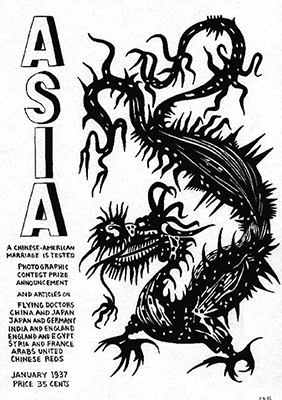Fernando Bryce copies existing texts and images that he finds in publication archives. He focuses on documents that were published in relation to shifts in geopolitical power, such as World War II, European colonization, and Pan-Americanism. The artist refers to his technique as “mimetic analysis.” He copies the existing text and image in his own aesthetic style, which is characterized by simple drawings that resemble of mid-twentieth century cartoons, and he replaces the texts with handwritten commentaries that have calligraphic traits.
Asia, the work presented in the Biennial, is made up of copies of a series of covers of the American magazine Asia, which was later called Asia and the Americas. This North American magazine was very popular in the 1920s and 1930s and was an important source of information for what was happening in the Middle and East Asia at the time. Like in many of his other works, Bryce organizes this series of covers in chronological order which makes a line of thinking becomes apparent, as well as a shift in representation based on the politics that were in vogue at that point. The series of Asia magazines give a distinct impression of how the East was perceived in the West in the 1920s and 1930s. They show the stereotypical and paternalistic way in which the local context was represented, which later gave way to images of an enemy when the situation changes during World War II.
Through reproduction, the images and text look at first like ironic representations, but then you realize that the artist didn’t add anything—the content was there already and the statements circulated among large groups of people, consolidating public opinion. Also, by putting the documents in an art context where cultural capital is generated, the attention shifts to another dimension, where other forms of representation are produced. In this case, the documents are restaged by anachronistic witnesses that bring to mind obstinate imperial representations.
Fernando Bryce, born 1965 in Peru, lives and works in Berlin

